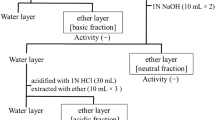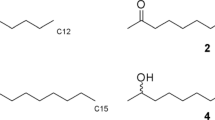Abstract
The poison gland, which is the source of the trail pheromone inDaceton armigerum, contains a mixture of dimethylpyrazine, trimethylpyrazine and 3-ethyl-2,5-dimethylpyrazine in approximately equal proportions, similar to that of the antManica rubida. The cross-activity in trail-following tests with several other species can thus be explained. The Dufour gland ofD. armigerum contains a mixture of 26 identified hydrocarbons, chiefly 9-tricosene, tricosane, and 9-pentacosene. It also contains very small amounts of two sesquiterpene aldehydes, tetramorine-2 and tetramorine-3, already known in other myrmicine Dufour glands. No volatile substances were detected in the pygidial gland.
Similar content being viewed by others
References
Ali, M.F., Morgan, E.D., Attygalle, A.B., andBillen, J.P.J. 1987. Comparison of Dufour gland secretion of two species ofLeptothorax ants (Hymenoptera: Formicidae).Z. Naturforsch. 42C:955–960.
Ali, M.F., Billen, J.P.J., Jackson, B.D., andMorgan, E.D. 1989. The Dufour gland contents of three species of Euro-AfricanMessor ants and a comparison with those of North AmericanPogonomyrmex (Hymenoptera: Formicidae).Biochem. Syst. Ecol. 17:469–477.
Attygalle, A.B., andMorgan, E.D. 1983. Trail pheromone of the antTetramorium caespitum (L.).Naturwissenschaften 70:364–365.
Attygalle, A.B., andMorgan, E.D. 1985. Ant trail pheromones.Adv. Insect Physiol. 18:1–30.
Attygalle, A.B., andMorgan, E.D. 1986. A versatile micro-reactor and extractor.Anal. Chem. 58:3054–3058.
Attygalle, A.B., Lancaster, V.K., andMorgan, E.D. 1985. The trail pheromone of the antManica rubida (Hymenoptera: Formicidae).Actes Coll. Insectes Soc. 2:159–166.
Attygalle, A.B., Cammaerts, M.C., Cammaerts, R., Morgan, E.D., andOllett, D.G. 1986. Chemical and ethological studies of the trail pheromone of the antManica rubida (Hymenoptera: Formicidae),Physiol. Entomol. 11:125–132.
Attygalle, A.B., Vostrowsky, O., Bestmann, H.J., Steghans-Kovac, S., andMaschwitz, U. 1988. (3R,4S)-4-Mefhyl-3-heptanol, the trail pheromone of the antLeptogenys diminuta.Naturwissenschaften 75:315–317.
Bagnères, A.G., Billen, J., andMorgan, E.D. 1991. The volatile secretion of the Dufour gland of workers of an army ant,Dorylus (Anomma) molestus.J. Chem. Ecol. 17:1633–1639.
Billen, J.P.J., Evershed, R.P., Attygalle, A.B., Morgan, E.D., andOllett, D.G. 1986. Contents of Dufour glands of workers of three species ofTetramorium (Hymenoptera: Formicidae).J. Chem. Ecol. 12:669–685.
Billen, J.P.J., Jackson, B.D., andMorgan, E.D. 1988. The contents of the pygidial gland of the primitive antNothomyrmecia macrops (Hymenoptera: Formicidae).Experientia 44:794–797.
Blum, M.S., andPortocarrero, C.A. 1966. Chemical releasers of social behaviour, X: An attine trail substance in the venom of non-trail laying myrmicine,Daceton armigerum (Latreille).Psyche 73:150–155.
Brown, W.L., andWilson, E.O. 1959. The evolution of dacetine ants.Q. Rev. Biol. 34:278–294.
Cross, J.H., Byler, R.C., Ravid, U. Silverstein, R.M., Robinson, S.W., Baker, P.M., De Oliveira, J.S., Jutsum, A.R., andCherrett, J.H. 1979. The major component of the trail pheromone of the leaf cutting antAtta sexdens nubropilosa Forel: 3-Ethyl-2,5-dimethylpyrazine.J. Chem. Ecol. 5:187–204.
Evershed, R.P., andMorgan, E.D. 1983. The amounts of trail pheromone substances in the venom of workers of four species of Attine ants.Insect Biochem. 13:469–474.
Hölldobler, B., Palmer, J.M., andMoffett, M.W. 1990. Chemical communication in the dacetine antDaceton armigerum (Hymenoptera: Formicidae).J. Chem. Ecol. 16:1207–1219.
Jackson, B.D. 1991. Chemical studies of volatiles from exocrine glands of ants. PhD thesis. University of Keele.
Jackson, B.D., Keegans, S.J., Morgan, E.D., Cammaerts, M.C., andCammaerts, R. 1990a. Trail pheromone of the antTetramorium meridionale (Hymenoptera: Formicidae).Naturwissenschaften 77:294–296.
Jackson, B.D., Morgan, E.D., andBillen, J.P.J. 1990b. Contents of the pygidial gland of the antMyrmecia nigriceps.Naturwissenschaften 77:187–188.
Meinwald, J., Wiemer, D.F., andHölldobler, B. 1983. Pygidial gland secretions of the ponerine antRhytidoponera metallica.Naturwissenschaften 70:46–47.
Morgan, E.D. 1990. Preparation of small scale samples from insects for chromatography.Anal. Chim. Acta 236:277–235.
Morgan, E.D., andWadhams, L.J. 1972. Chemical constituents of Dufour's gland in the antMyrmica rubra L.J. Insect Physiol. 18:1125.
Riley, R.G., Silverstein, R.M., Carroll, B., andCarroll, R. 1974. Methyl 4-methyl-pyrrole-2-carboxylate, a volatile trail pheromone from the leaf cutting antAtta cephalotes.J. Insect Physiol. 20:651–654.
Robinson, S.W., Maser, J.C., Blum, M.S., andAmante, E. 1974. Trail following responses of four leaf-cutting ants with notes on the specificity of the trail pheromone ofAtta texana.Insectes Soc. 00:87–89.
Vander Meer, R.K. 1986. The trail pheromone complex ofSolenopsis invicta andSolenopsis richteri, pp. 201–210,in C.S. Lofgren and R.K. Vander Meer (eds.). Fire Ants and LeafCutting Ants: Biology and Management. Westview Press, Boulder, Colorado.
Wilson, E.O. 1962. Behaviour ofDaceton armigerum (Latreille), with a classification of selfgrooming movements in ants.Bull. Mus. Comp. Zool. 127:401–422.
Author information
Authors and Affiliations
Rights and permissions
About this article
Cite this article
Morgan, E.D., Hölldobler, B., Vaisar, T. et al. Contents of poison apparatus and their relation to trail-following in the antDaceton armigerum . J Chem Ecol 18, 2161–2168 (1992). https://doi.org/10.1007/BF00984943
Received:
Accepted:
Issue Date:
DOI: https://doi.org/10.1007/BF00984943




